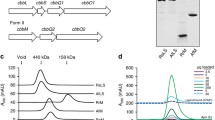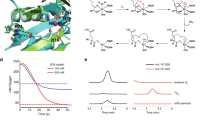Abstract
Ribulose-1,5-bisphosphate carboxylase/oxygenase (RuBisCO) is the key catalyst of CO2 fixation in nature. RuBisCO forms I, II, and III catalyze CO2 fixation reactions, whereas form IV, also called the RuBisCO-like protein (RLP), is known to have no carboxylase or oxygenase activities. Here, we describe an RLP in Ochrobactrum anthropi ATCC 49188 (Oant_3067; HamA) that functions as an oxygenase in the metabolism of d-hamamelose, a branched-chain hexose found in most higher plants. The d-hamamelose pathway is comprised of five previously unknown enzymes: d-hamamelose dehydrogenase, d-hamamelono-lactonase, d-hamamelonate kinase, d-hamamelonate-2′,5-bisphosphate dehydrogenase (decarboxylating), and the RLP 3-keto-d-ribitol-1,5-bisphosphate (KRBP) oxygenase, which converts KRBP to 3-d-phosphoglycerate and phosphoglycolate. HamA represents the first RLP catalyzing the O2-dependent oxidative C–C bond cleavage reaction, and our findings may provide insights into its applications in oxidative cleavage of organic molecules.
Similar content being viewed by others
Change history
17 January 2019
In the 2018 issue of Biotechnology and Bioprocess Engineering (BBE), an error occurred in the research article: Suk Min Kim, Hyun Seung Lim, and Sun Bok Lee (2018) Discovery of a RuBisCO-like Protein that Functions as an Oxygenase in the Novel <Emphasis Type="SmallCaps">d</Emphasis>-Hamamelose Pathway. <Emphasis Type="Italic">Biotechnol. Bioprocess Eng.</Emphasis> 23: 490–499. In Fig. 3, <Emphasis Type="SmallCaps">l</Emphasis>-Lyxose and <Emphasis Type="SmallCaps">l</Emphasis>-Lyxonate should be replaced by <Emphasis Type="SmallCaps">d</Emphasis>-Ribose and <Emphasis Type="SmallCaps">d</Emphasis>-Ribonate, respectively.
References
Griffin, K. L. and J. R. Seemann (1996) Plants, CO2 and photosynthesis in the 21st century. Chem. Biol. 3: 245–254.
Erb, T. J. and J. Zarzycki (2018) A short history of RubisCO: the rise and fall (?) of Nature’s predominant CO2 fixing enzyme. Curr. Op. Biotechnol. 49: 100–107.
Ellis, R. J. (1979) The most abundant protein in the world. Trends Biochem. Sci. 4: 241–244.
Tabita, F. R., T. E. Hanson, H. Y. Li, S. Satagopan, J. Singh, and S. Chan (2007) Function, structure, and evolution of the RubisCO-like proteins and their RubisCO homologs. Microbiol. Mol. Biol. Rev. 71: 576–599.
Tabita, F. R., S. Satagopan, T. E. Hanson, N. E. Kreel, and S. S. Scott (2008) Distinct form I, II, III, and IV rubisco proteins from the three kingdoms of life provide clues about RuBisCO evolution and structure/function relationships. J. Exp. Bot. 59: 1515–1524.
Ashida, H., Y. Saito, C. Kojima, K. Kobayashi, N. Ogasawara, and A. Yokota (2003) A functional link between RuBisCO-like protein of Bacillus and photosynthetic RuBisCO. Science 302: 286–290
Erb, T. J., B. S. Evans, K. Cho, B. P. Warlick, J. Sriram, B. M. Wood, H. J. Imker, J. V. Sweedler, F. R. Tabita, and J. A. Gerlt (2012) A RubisCO-like protein links SAM metabolism with isoprenoid biosynthesis. Nat. Chem. Biol. 8: 926–932.
Kim, S. M., K. H. Paek, and S. B. Lee (2012) Characterization of NADP+-specific L-rhamnose dehydrogenase from the thermoacidophilic Archaeon Thermoplasma acidophilum. Extremophiles 16: 447–454.
Bae, J., S. M. Kim, and S. B. Lee (2015) Identification and characterization of 2-keto-3-deoxy-L-rhamnonate dehydrogenase belonging to the MDR superfamily from the thermoacidophilic bacterium Sulfobacillus thermosulfidooxidans: implications to Lrhamnose metabolism in archaea. Extremophiles 19: 469–478.
Cho, S. J. and S. B. Lee (2014) Identification and characterization of 3, 6-anhydro-L-galactose dehydrogenases belonging to the aldehyde dehydrogenase superfamily from marine and soil microorganisms. Biotechnol. Bioprocess Eng. 19: 1058–1068.
Lee, S. B., S. J. Cho, J. A. Kim, S. Y. Lee, S. M. Kim, and H. S. Lim (2014) Metabolic pathway of 3, 6-anhydro-L-galactose in agar-degrading microorganisms. Biotechnol. Bioprocess Eng. 19: 866–878.
Lee, S. B., J. A. Kim, and H. S. Lim (2016) Metabolic pathway of 3,6-anhydro-D-galactose in carrageenan-degrading microorganisms. Appl. Microbiol. Biotechnol. 100: 4109–4121.
Morinaga, T., H. Ashida, and K. Yoshida (2010) Identification of two scyllo-inositol dehydrogenases in Bacillus subtilis. Microbiology 156: 1538–1546.
Johnsen, U., M. Dambeck, H. Zaiss, T. Fuhrer, J. Soppa, U. Sauer, and P. Schonheit (2009) D-xylose degradation pathway in the halophilic archaeon Haloferax volcanii. J. Biol. Chem. 284: 27290–27303.
Geddes, B. A., B. S. Pickering, N. J. Poysti, H. Collins, H. Yudistira, and I. J. Oresnik (2010) A locus necessary for the transport and catabolism of erythritol in Sinorhizobium meliloti. Microbiology 156: 2970–2981.
Bradford, M. M. (1976) A rapid and sensitive method for the quantitation of microgram quantities of protein utilizing the principle of protein-dye binding. Anal. Biochem. 72: 248–254.
Hricovíniová, Z., M. Hricovíni, and L. Petruš (1998) Stereospecific molybdic acid-catalyzed isomerization of D-fructose to branched-chain aldose. The synthesis of D-hamamelose. Chem. Papers 52: 692–698.
Moore, S. and K. P. Link (1940) Carbohydrate Characterization I. The oxidation of aldoses by hypoiodite in methanol, II. The identification of seven aldo-monosaccharides as benzimidazole derivatives. J. Biol. Chem. 133: 293–311.
Weimberg, R. (1959) L-2-Keto-4,5-dihydroxyvaleric acid: an intermediate in the oxidation of L-arabinose by Pseudomonas saccharophila. J. Biol. Chem. 234: 727–732.
Wu, J. T., L. H. Wu, and J. A. Knight (1986) Stability of NADPH: effect of various factors on the kinetics of degradation. Clin. Chem. 32: 314–319.
Kim, S. and S. B. Lee (2006) Characterization of Sulfolobus solfataricus 2-keto-3-deoxy-D-gluconate kinase in the modified Entner-Doudoroff pathway. Biosci. Biotechnol. Biochem. 70: 1308–1316.
Gutteridge, S., M. A. J. Parry, S. Burton, A. J. Keys, A. Mudd, J. Feeney, J. C. Servaites, and J. Pierce (1986) A nocturnal inhibitor of carboxylation in leaves. Nature 324: 274.
Ulrich, E. L., H. Akutsu, J. F. Doreleijers, Y. Harano, Y. E. Ioannidis, J. Lin, M. Livny, S. Mading, D. Maziuk, Z. Miller, E. Nakatani, C. F. Schulte, D. E. Tolmie, R. Kent Wenger, H. Yao, and J. L. Markley (2007) BioMagResBank. Nucleic Acids Res. 36: D402–D408.
Beck, E., H. Stransky, and M. Fürbringer (1971) Synthesis of hamamelose-diphosphate by isolated spinach chloroplasts. FEBS Lett. 13: 229–234.
Sellmair, J., E. Beck, O. Kandler, and A. Kress (1977) Hamamelose and its derivatives as chemotaxonomic markers in the genus Primula. Phytochemistry 16: 1201–1204.
Yoshimura, J. (1984) Synthesis of branched-chain sugars. Carbohydr. Chem. Biochem. 42: 69–134.
Zhang, X., M. S. Carter, M. W. Vetting, B. San Francisco, S. Zhao, N. F. Al-Obaidi, J. O. Solbiati, J. J. Thiaville, V. de Crecy-Lagard, M. P. Jacobson, S. C. Almo, and J. A. Gerlt (2016) Assignment of function to a domain of unknown function: DUF1537 is a new kinase family in catabolic pathways for acid sugars. Proc. Natl. Acad. Sci. USA 113: E4161–4169.
Logue, M. W., R. M. Pollack, and V. P. Vitullo (1975) Nature of the transition state for the decarboxylation of ß-keto acids. J. Am. Chem. Soc. 97: 6868–6869.
Lorimer, G. H., T. J. Andrews, and N. E. Tolbert (1973) Ribulose diphosphate oxygenase. II. Further proof of reaction products and mechanism of action. Biochemistry 12: 18–23.
Hartman, F. C. and M. R. Harpel (1994) Structure, function, regulation, and assembly of D-ribulose-1, 5-bisphosphate carboxylase/ oxygenase. Annu. Rev. Biochem. 63: 197–232.
Tcherkez, G. (2016) The mechanism of rubisco-catalysed oxygenation. Plant Cell Environ. 39: 983–997.
Portis, A. R. and M. A. Parry (2009) rubisco. In Encyclopedia of Life Sciences; John Wiley, Chichester, DOI: 10.1002/9780470015902.a0001293.pub2.
Author information
Authors and Affiliations
Corresponding author
Electronic supplementary material
Rights and permissions
About this article
Cite this article
Kim, S.M., Lim, H.S. & Lee, S.B. Discovery of a RuBisCO-like Protein that Functions as an Oxygenase in the Novel d-Hamamelose Pathway. Biotechnol Bioproc E 23, 490–499 (2018). https://doi.org/10.1007/s12257-018-0305-6
Received:
Accepted:
Published:
Issue Date:
DOI: https://doi.org/10.1007/s12257-018-0305-6




